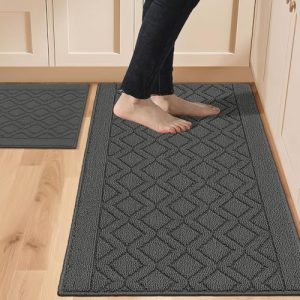Are you ready to install a new kitchen sink but unsure how to cut the perfect hole in your countertop? You might feel nervous about making a mistake that could ruin your beautiful surface.
Don’t worry—cutting a hole for your kitchen sink is easier than you think when you follow the right steps. In this guide, you’ll discover simple tips and clear instructions to help you create a clean, precise cut every time. Keep reading to gain the confidence and know-how to tackle this project yourself and save money on costly professional help.
Your dream kitchen upgrade starts here!
Tools And Materials Needed
Cutting out a hole for a kitchen sink requires specific tools and materials. Using the right equipment makes the job easier and safer. Prepare all items before starting the work. This helps avoid interruptions and mistakes.
Essential Tools
- Measuring tape – for accurate measurements
- Pencil or marker – to mark the cut lines
- Jigsaw or hole saw – to cut the countertop
- Drill – for making starter holes
- Clamps – to secure the countertop during cutting
- Sandpaper or file – to smooth the edges
- Utility knife – for trimming any sealant or caulk
Required Materials
- New kitchen sink
- Silicone sealant – to waterproof the edges
- Masking tape – to protect the countertop surface
- Cleaning cloth – to wipe dust and debris
- Template or sink cut-out guide – often comes with the sink
Safety Gear
- Safety glasses – to protect your eyes from dust
- Work gloves – to protect your hands from sharp edges
- Dust mask – to avoid inhaling dust particles
- Hearing protection – if using loud power tools
Choosing The Right Sink
Choosing the right sink is a crucial step before cutting out the hole in your kitchen countertop. The sink you pick influences not only the size and shape of the cutout but also how your kitchen functions daily. Understanding your options and planning carefully will save you from costly mistakes and make installation smoother.
Types Of Kitchen Sinks
There are several types of kitchen sinks, each with its own installation style and design. Popular options include:
- Top-mount sinks: These sit on top of the counter with a rim that covers the cut edge. They are easier to install and usually require a slightly smaller cutout.
- Undermount sinks: These attach beneath the countertop, creating a seamless look. The cutout must be precise, as the sink lip is hidden.
- Farmhouse (apron-front) sinks: These have a front panel that extends beyond the cabinet. They need special cabinet modifications and a carefully measured cutout.
Think about how each type fits your kitchen style and cleaning habits. Have you considered how much counter space you want around the sink?
Measuring For Fit
Accurate measurements are essential before cutting the hole. Start by checking the sink’s dimensions, including length, width, and depth.
Mark the sink outline on the countertop with a pencil, double-checking the alignment with cabinets and fixtures. Remember to leave space for mounting clips or seals as specified by the sink manufacturer.
I once underestimated the depth of my sink, which made installation difficult. Don’t rush this step—measure twice to avoid surprises.
Selecting Sink Location
Where you place your sink affects workflow and plumbing setup. Consider proximity to the dishwasher, stove, and refrigerator for easier meal prep and cleanup.
Also, check for plumbing access under the cabinet to ensure connections are straightforward. Avoid placing your sink too close to a wall, which can limit workspace and make the cutout tricky.
Ask yourself: Will this location make your daily kitchen tasks easier or more complicated?
Preparing The Countertop
Preparing the countertop is a crucial step before cutting out the hole for your kitchen sink. Careful preparation helps avoid mistakes and damage. It makes the whole process smoother and safer.
Clearing The Workspace
Remove all items from the countertop. Clear dishes, small appliances, and cleaning supplies. Wipe down the surface to remove dust and grease. A clean workspace helps you see the cutting area clearly. It also prevents accidents and damage during cutting.
Marking The Cutout Area
Use the sink template or the sink itself to trace the cutout shape. Place it upside down on the countertop. Use a pencil to draw the outline carefully. Make sure the lines are clear and visible. Mark the inside edge to guide your saw accurately.
Double-checking Measurements
Measure the sink dimensions again before cutting. Check the distance from edges and cabinets. Confirm the outline matches the sink’s size exactly. Measure twice to avoid cutting errors. Accurate measurements save time and materials.
Cutting The Hole
Cutting the hole for your kitchen sink is a task that requires precision and care. A poorly cut hole can lead to leaks or an ill-fitting sink. Taking your time and using the right tools will make the process smoother and safer.
Drilling Starter Holes
Start by marking the exact outline of your sink on the countertop. Use a pencil or painter’s tape to create a clear guide. Then, drill starter holes just inside the corners of the marked area; these holes give your jigsaw a place to enter without damaging the countertop.
Make sure your drill bit matches the thickness of the countertop material. If you’re working with granite or tile, use a specialized drill bit designed for hard surfaces. Have you checked that your drill is fully charged or plugged in? Running out of power mid-cut is frustrating and can ruin your work.
Using The Jigsaw Safely
Insert the jigsaw blade into one of the starter holes and begin cutting along the marked line. Keep the saw steady and move slowly to maintain control and accuracy. Rushing increases the risk of mistakes or injury.
Wear safety goggles and a dust mask to protect yourself from debris. If your countertop material is particularly hard or thick, consider using a blade designed specifically for that material. Have you secured the countertop so it doesn’t shift during cutting? Stability is key to clean cuts.
Smoothing The Edges
Once the hole is cut, the edges will likely be rough and uneven. Use a sanding block or a rotary tool with a sanding attachment to smooth them out. This step prevents damage to the sink and ensures a snug fit.
Be gentle while sanding to avoid chipping the countertop. If you notice any cracks or chips, seal them with a suitable adhesive or filler. How clean and smooth your edges are can determine the longevity of your sink installation.
Installing The Sink
Installing the kitchen sink requires precision and care. It can seem daunting, but breaking it into steps makes it manageable. Focus on applying sealant, positioning the sink, and securing it in place. This ensures a snug, leak-free fit. Let’s explore each step in detail.
Applying Sealant
Start by cleaning the sink’s edge. Remove any debris or dust. Apply a bead of sealant around the sink’s perimeter. Ensure an even layer to prevent leaks. Use a caulking gun for accuracy. Let it sit for a few minutes to slightly set.
Positioning The Sink
Carefully lower the sink into the cut-out hole. Align it with the countertop edges. Ensure the sink is centered. Adjust as necessary for a perfect fit. Press down gently to embed it in the sealant. Double-check the alignment visually.
Securing The Sink In Place
Use the provided clips or brackets to secure the sink. Attach them under the countertop. Tighten them evenly to avoid shifting. Check that the sink is firmly attached. Wipe away any excess sealant with a damp cloth. This secures the sink, preventing movement and leaks.
Final Checks And Cleanup
After cutting out the hole for your kitchen sink, the final steps are crucial to ensure everything works perfectly and looks great. Paying close attention to these last details can save you from future headaches like leaks or damage. Let’s focus on how to test for leaks, clean up the workspace, and maintain your sink cutout for the long term.
Testing For Leaks
Before sealing everything up, check for leaks by running water through the sink and closely watching the edges and plumbing connections.
Use a dry cloth or paper towel to detect any moisture around the seal. If you spot any damp spots, tighten the fittings or apply additional sealant as needed.
Consider turning on both hot and cold water taps to test how well the sink handles different water pressures. Are you noticing any drips or slow drainage? This is the moment to catch those issues.
Cleaning The Area
Remove all dust, debris, and leftover materials from the cutting process. A clean surface not only looks better but also helps the sink seal properly.
Use a vacuum or brush to clear out sawdust from the edges, then wipe down the countertop with a damp cloth. Avoid harsh chemicals that might damage your countertop finish.
Don’t forget to clean the sink itself before installation to prevent dirt from getting trapped under the edge. A little extra effort now saves you time and frustration later.
Maintaining Your Sink Cutout
Regularly inspect the seal around your sink for cracks or wear, especially after heavy use or cleaning. Small issues caught early prevent costly repairs.
Protect the edges of your cutout by avoiding sharp tools or heavy pots near the sink rim. Gentle handling preserves the integrity of your work.
Have you tried applying a thin layer of silicone sealant around the sink edge? It creates a waterproof barrier and extends the life of your cutout.
Frequently Asked Questions
How Do I Measure For A Kitchen Sink Hole?
Measure the sink’s dimensions, including width and length. Mark the countertop with a pencil using the sink template or measurements. Ensure the cutout is slightly smaller for a snug fit.
What Tools Are Needed To Cut A Kitchen Sink Hole?
You’ll need a jigsaw, drill, measuring tape, pencil, clamps, and safety gear. These tools ensure a clean, precise cut for your kitchen sink installation.
How To Prevent Countertop Damage While Cutting?
Use painter’s tape around the cut line to avoid splintering. Cut slowly and steadily with a sharp blade to protect the surface.
Can I Cut A Sink Hole In Granite Or Laminate?
Yes, but granite requires a diamond blade and professional skill. Laminate is easier but needs careful cutting to avoid chipping edges.
Conclusion
Cutting a hole for your kitchen sink is easier than it seems. Take your time and measure carefully. Use the right tools to make clean cuts. Always wear safety gear to protect yourself. Follow each step in order to avoid mistakes.
With patience, you can do the job well. Enjoy your new sink space once done. Keep practicing to improve your skills. Simple tasks like this build home confidence. Ready to start your kitchen project?

Sophie Hartwell is the founder of KitchenQuik.com, where she shares kitchen tips, smart cooking hacks, and the best product picks to make everyday cooking easier and more enjoyable.




